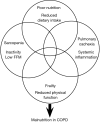Nutritional support in chronic obstructive pulmonary disease (COPD): an evidence update
- PMID: 31737350
- PMCID: PMC6831917
- DOI: 10.21037/jtd.2019.10.41
Nutritional support in chronic obstructive pulmonary disease (COPD): an evidence update
Abstract
Chronic obstructive pulmonary disease (COPD) primarily affects the lungs but due to the accompanying chronic systematic inflammation and the symptoms associated with the disease there are many extrapulmonary effects which include complex physical and metabolic adaptations. These changes have been associated with reduced exercise capacity, increased nutritional requirements, altered metabolic processes and compromised nutritional intake. As a result, nutritional depletion in COPD is multi-faceted and can involve imbalances of energy (weight loss), protein (sarcopenia), and periods of markedly increased inflammation (pulmonary cachexia) which can increase nutritional losses. As a result, depletion of both fat-mass (FM) and fat-free mass (FFM) can occur. There is good evidence that nutritional support, in the form of oral nutritional supplements (ONS), can overcome energy and protein imbalances resulting in improved nutritional status and functional capacity. However, in order to treat the aetiology of sarcopenia, frailty and cachexia, it is likely that targeted multi-modal interventions are required to address energy and protein imbalance, specific nutrient deficiencies, reduced androgens and targeted exercise training. Furthermore, interventions taking a disease-course approach, are likely to hold the key to effectively managing the common and costly problem of nutritional depletion in COPD.
Keywords: Chronic obstructive pulmonary disease (COPD); malnutrition; nutrition support.
2019 Journal of Thoracic Disease. All rights reserved.
Conflict of interest statement
Conflicts of Interest: The authors have no conflicts of interest to declare.
Figures
References
-
- GOLD. Global strategy for the diagnosis, management, and prevention of chronic obstructive pulmonary disease (2019 Report). 2019.
Publication types
LinkOut - more resources
Full Text Sources
Research Materials

